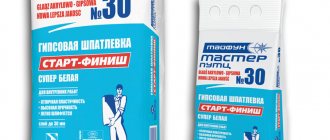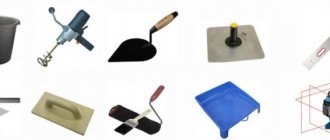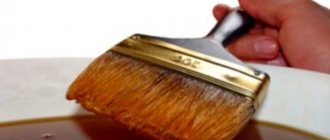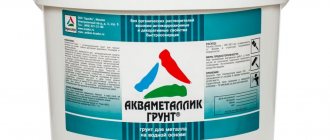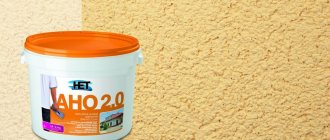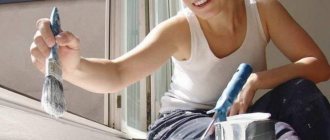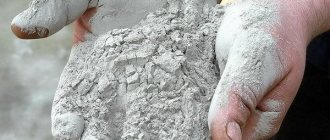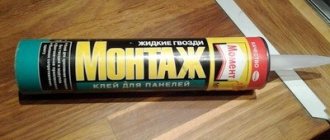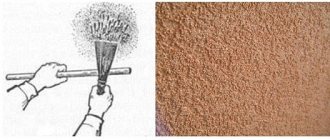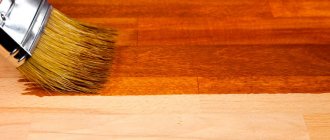Being one of the oldest building materials, wood has not lost its relevance for thousands of years. Environmental friendliness, excellent external characteristics and ease of processing are the qualities that distinguish wood.
In order to preserve wooden buildings and products, it is necessary to impregnate wood from moisture and rotting. We will discuss in the article which is the best one on the market and how to make the right choice of products for interior and exterior work.
Impregnated log house
Why is wood protective treatment necessary?
The following can have a negative impact on wooden structures:
- exposure to moisture;
- sudden change in temperature;
- bugs and fungal formations;
- direct contact with open fire.
Impregnation for wood
To reduce the influence of these factors, protective treatment is carried out using special protective compounds. After treatment with such preparations, the performance characteristics and resistance of various types of wood to harmful influences are significantly increased, in addition, the service life of wooden structures and their aesthetic characteristics are significantly increased.
It is recommended to select the chemical composition of the impregnation based on the specific operating conditions of the building and its design features. So, for a sauna or bathhouse, a hydrophobic composition is more suitable, and for a forest building it is better to use a drug with antiseptic properties.
Products that can protect wood from excess moisture
All means protecting wood from excess moisture are divided into 2 types:
- Penetrating. They penetrate deep into the wood and create a certain barrier to moisture in its structure. These compounds include antiseptics. The most effective and proven are Neomid 440 ECO, Neomid EXTRA ECO, as well as Prosept Exterior, Prosept Ultra. These are environmentally friendly antiseptic agents that can be used to treat wood located in damp rooms or outdoors. They are able to protect wood for a long time from excess moisture, the formation of fungi, rot, and mold.
- Film-forming. They create a film on the surface of the wood that prevents moisture from entering the wood structure. To provide the necessary protection from moisture, you can purchase Neomid Biocolor Ultra, Neomid Biocolor, Neomid Biocolor Aqua, Prosept BiO Lasur. These are decorative impregnations that will not only protect the wooden material from high humidity, but will also change its appearance for the better.
Classification of protective equipment
In accordance with GOST 20022.2-80, there are three groups of wood impregnations
| Designation | Wood varieties | |
| Sapwood | Core | |
| Easy to impregnate | Scots pine, ash, beech, birch | |
| Moderately soaked | Siberian pine (cedar), hornbeam, European larch, aspen, alder, maple, linden, oak, hornbeam | Siberian pine (cedar), Scots pine, alder, aspen |
| Difficult to soak | Siberian larch, fir, spruce | Larch, ash, oak, elm, birch, beech, fir |
Protective impregnations for external use are classified according to the following criteria:
- by type of impact
- antiseptic
- flame retardants
- universal
- by solubility
- VR – water soluble
- L – soluble in light organic solvents
- M – soluble in heavy petroleum products and oils
- by washability
- LV - easy to wash out
- B – washable
- TV – difficult to wash out
- NV – non-washable
Impregnations for wood for external use are produced according to this classification and are regulated by GOST 20022.2-80.
Compound
Experts advise giving priority to aqueous formulations. They are the most versatile, environmentally friendly, applied manually and mechanically.
When considering antiseptics, you should not ignore acrylic preparations. They have excellent water protection characteristics and are affordable. However, they have one drawback - the inability to work at low temperatures.
There is one more component on the basis of which wood impregnations are produced - these are organic solvents. Such compositions have excellent protective properties, but caution should be exercised when using them due to the toxicity of many compositions.
When choosing which antiseptic for wood is better to choose, you can immediately select the appropriate color of the composition, since the impregnation can also have decorative functions and change the shade of the wood.
Color
If you plan to preserve the natural shade of the wood, the mixture is selected to be colorless and have a number of protective characteristics. To give the solid wood the desired shade of more expensive species, colored wood impregnations are used. However, simple painting and impregnation should not be confused. In the first case, an opaque color background is formed, and in the second, transparency is maintained and the structure is visible.
It is not advisable to do tinting. It’s easier to choose the impregnation you like most using the shade chart in the store.
Application is carried out in any convenient way in several stages, between which there is a pause while the previous layer dries completely.
Types of impregnation
When deciding which antiseptic is best, first of all, you need to learn how to choose it correctly. Manufacturers produce formulations on a variety of bases and with a variety of functions.
But, in general, they are divided into means:
- on an oil, water and alcohol chemical basis,
- surface, neutral and deep penetrating impregnations,
- organic and chemical products,
- antiseptics and fire retardants,
- decorative and colorless.
All of them are used to protect wood. But some only create a surface layer, while others penetrate deeply into the structure and change its properties.
Oil impregnations have a varnish base, while water impregnations are based on compounds of sodium fluoride, boric acid and zinc chloride and penetrate the structure of the wood. Acrylic water-based compositions are popular and practically harmless, but alcohol impregnations quickly evaporate.
Antiseptics disinfect wood, fight fungus and mold, and fire retardants protect against fire. Decorative impregnations change the color of the wood, thereby achieving a decorative and beautiful coating, while colorless impregnations preserve the natural shade and texture of the wood.
Impregnation of a log house without coloring
Water based
Water-based impregnations are available in completely finished form. They are distinguished by the absence of an unpleasant odor , therefore they are suitable for both external and internal work.
A water base means applying the product even to a damp surface or to salt coatings, the combination of which is ineffective with solvent-based liquids.
Application is carried out with a brush or spray, using the vacuum method by soaking. The product dries quickly and penetrates deeply into the wood, but has one limitation - it cannot be used to process old, dry material . This leads to swelling of the latter and the formation of cracks on it.
According to their intended purpose, substances can have antiseptic, fire-fighting and decorative properties, and protect against getting wet. They have lower wear resistance compared to other products.
Acrylic based
Acrylic-based impregnations are used to protect and decorate wooden surfaces both outside and inside. They are environmentally friendly for humans and odorless.
Such mixtures have strengthening and water-repellent properties and can perfectly protect against fungus, mold and rot. After applying impregnation, the service life of the material increases.
The array can be processed at any stage of construction. Apply the product with a brush or spray.
The disadvantages of acrylic impregnations include intolerance to low temperatures.
Salt based
Salt impregnations are available in powder or ready-made solution form. They are most often used to treat rafter systems to protect them from fungi, mold and pests. In addition, due to the settling of salt crystals, such products effectively protect against fire.
Application with a brush is possible, but the greatest effect can only be achieved by soaking or processing in a vacuum chamber. For this reason, mixtures are rarely used in everyday life, but such processing can be ordered in production.
Oil based
Oil impregnations have high water-repellent properties. They are actively used to cover wooden structures and furniture that are located outdoors and are constantly exposed to precipitation.
The oil in the base of the product penetrates deeply into the fibers of the array, preventing it from drying out and cracking, as well as exposure to dirt and dust. The product treated with impregnation slightly changes color, while acquiring a beautiful shiny surface.
This coating is not durable. It must be renewed every year, applying with a spray or brush in several layers.
Disadvantages include the flammability of the mixture and the inability to apply other products on top of it.
Based on alkyd resins
Alkyd impregnations contain antiseptic additives, oil and wax. The mixtures perfectly highlight the natural beauty of wood, protect it from mold, fungi and exposure, both atmospheric and physical.
After application with a brush or roller, there is a long drying time , which many consider to be a significant drawback of such a product.
Bitumen based
Bitumen impregnation is a thick black mass. The mixture is based on gasoline and diesel fuel. Most often, the product is made independently and is intended exclusively for external work due to its high toxicity and pungent odor.
Any type of wood can be processed, even dried. After application, a dense protective layer is formed that prevents the development of harmful bacteria and fungi and insect attacks.
The composition implies protection from moisture, but high flammability.
Silicone
Silicone impregnation has all the positive characteristics of other types of products : water-repellent, antiseptic, protects against ultraviolet radiation and biological destruction. In this case, the mixture does not form a film, allowing the array to breathe.
Apply in any convenient way. Sold as concentrated or simple liquids.
Bottom line
First answer the questions above. Once you have done this, you can make the necessary choices. Remember that wooden products have many enemies, so you need to choose an antiseptic for them that will help deal with them all.
Don't save your money. Motor, transformer, and linseed oils should not be used because they can ruin the appearance. Domestic producers are suitable for wood. They will be able to fight moisture, fire, ultraviolet rays and pests, and help create a hydrophobic coating. You will be satisfied with the insulation.
Types of impregnations by purpose
Impregnation for wood can have different characteristics depending on the type of effect. In each individual case, the one that suits the most is selected.
Antiseptics
The antiseptic properties of the impregnation are aimed at protecting the wood from rotting and the formation of fungus and mold , and from attacks by various insects. Their individual components exclude the influence of biological factors.
A good antiseptic is highly durable. It penetrates deeply into the structure of the material, has no unpleasant odor and is completely harmless to people. For protection during storage and transportation, surface spraying is performed. During installation, treatment by soaking is recommended.
Fire protection
To protect against fire, acid, alkaline and salt impregnations are used. With additional protective layers, such products provide high fire safety and retain their characteristics for a long time. The mixtures are completely safe for living beings.
Acidic compounds are the most reliable in this matter. This ensures additional strength of the material while maintaining hygroscopic characteristics.
Alkaline impregnations are used much less frequently. They disrupt the structure of the wood and are not at all suitable for treating visible surfaces.
Saline solutions are considered the most ineffective. Over time, salt crystals appear on the surface and spoil the appearance of the product.
The validity period of the fireproof layer on external surfaces is 2 years. For interior work – 5 years. The principle of operation is that the substances included in the impregnation melt under the influence of high temperatures and form a thin film that prevents the penetration of oxygen.
Frost resistance
Frost-resistant liquids are designed to preserve the properties of wood at temperatures around -40 ° C. They have antiseptic and protective characteristics.
Water repellent effect
Thanks to the presence of wax and oils in the composition, absolute protection of the wood from moisture penetration . Since the massif is destroyed even by hydrogen in the air, almost all impregnations have this effect, but there are also special products that are intended for treating surfaces in baths and saunas, for external work.
Decorative properties
Decorative impregnation for wood, most often acrylic, is used to emphasize the natural texture of the solid wood . For decorative purposes, choose products with the desired shade, matte or glossy film that forms after drying.
Complex impregnations
Most impregnations have many properties at once , have a complex composition, and are available in the form of concentrates.
The most popular are antiseptic impregnations with water-repellent and fire-fighting properties.
For interior work
When choosing an impregnation for treating wood that will be or has already been installed indoors, first of all, pay attention to the environmental friendliness and safety of the solution. These requirements are met by water-based products containing natural solvents and oils.
Conventionally, all products in this line can be divided into 3 groups :
- antiseptics, which are designed to protect against rotting, mold and mildew, temperature changes, changes in shape and color;
- moisture-proof, which are used to treat baths to protect the array from constant exposure to high temperatures and moisture;
- fire retardant, significantly or completely reducing the risk of fire.
For outdoor use
When processing wood that will constantly be outdoors and exposed to various harmful and atmospheric factors , it is recommended to use more aggressive impregnations. At the same time, harm to health and environmental friendliness, due to the work being carried out outdoors, fade into the background.
First of all, antiseptic impregnation is used, which will not only prevent various microorganisms from living and multiplying in the structure of the tree, destroying it, but will also preserve its appearance, since during the life of bacteria and fungi the material turns black.
If the surface has previously been given the desired shade, the impregnation should protect against ultraviolet radiation.
Important! The most caustic impregnations are bitumen. Mixtures are used to treat load-bearing structures. After their application, the tree is not afraid of either moisture or attacks by microorganisms. Even rodents are not afraid of him.
Damage caused to wood by moisture
If the wood contains a large amount of moisture exceeding 15%, then the structure of the material begins to change significantly. Excess moisture in wood reduces its strength. The wood will dry first from the outside and then from the inside, and there will be strong pressure on the inside, as a result of which a large crack may form, which will spoil the strength characteristics of the material.
Due to moisture, mold and mildew often appear on the surface of wood. They can become the main cause of the formation of rot, the consequences of which can no longer be corrected. And if the wood is treated with a water-repellent composition, then moisture will not penetrate into the structure of the wooden material through the pores and thereby prevent unpleasant phenomena that can occur with the wooden material.
Functions of wood impregnations
Depending on the composition and purpose, wood impregnations can:
- protect against fungus and mold, prevent rotting processes;
- ensure a sufficient level of biological protection. The substances included in the composition have a negative effect on grinder beetles;
- increase fire-resistant properties. The introduction of salt into the composition of wood impregnations makes it possible to increase the wood's resistance to fire, slowing down the process of destruction;
- reduce the consumption of paints and varnishes due to more thorough rough preparation of the wooden surface for painting. At the same time, adhesion to the finishing coating increases significantly;
- protect the tree from moisture;
- give the desired shade.
Impregnation protects the wood
Leading manufacturers
Many manufacturers offer quality products. The leading position is traditionally occupied by wood impregnation, produced under the following trademarks:
- LuxDecor Plus . Products of the highest quality. The manufacturer offers water-soluble, acrylic composition and many others;
- Mokke Foressa. The manufacturer offers alkyd impregnation to protect and decorate wood;
- Belinka. A company from Slovenia produces deep penetration impregnations;
- Pinotex. A company from the Netherlands offers several types of protective equipment;
- Senezh. Domestic products are offered by NPO Drevozashchita. The company's catalog presents all types of wood impregnations, which will allow you to choose the best option for any substrate;
- North. The domestic manufacturer offers professional protective products that can reliably protect wooden bases from external negative factors;
- Dufa. German products are represented by several types of protective equipment. Available with or without wax. Colored and colorless;
- Tikkurila. The catalog of the Finnish concern presents a variety of products that perform various functions;
- Aquatex. The domestic company offers a range of combined mixtures;
- Neomid. The Russian company produces the best impregnations for fire protection of wood, as well as a number of others that allow you to reliably protect the base from many other factors;
- KSD. High-quality impregnation is produced by Russian. Used for internal and external protection;
- MÖKKE. The brand offers high-quality antiseptic formulations manufactured using unique Finnish technologies. The formed coating can provide half a century of protection for wood from adverse natural factors.
Rules for treating wood with impregnation
To ensure high-quality protection, impregnation must be applied to the surface of the wood in compliance with certain rules:
- solutions with low viscosity, for example, aqueous ones, are sprayed over the surface of the base. For a thick composition, it is preferable to use a roller or brush;
- It takes different times for the solution to dry: the water solution will dry in a couple of hours, the rest may remain sticky even after a day;
- when forming a protective coating using impregnation that can have a negative impact on human health, you should wear PPE;
- You should make sure that there are no children or animals near the processing area. The impact of impregnation on them will be more negative than on adults;
- you should follow the manufacturer’s recommendations and apply a sufficient number of protective layers;
- Follow the frequency of treatment of wood with impregnation specified in the application instructions.
The tool is selected individually
Attention! The chosen application method can seriously affect the consumption of impregnation. For an aqueous solution, spraying with a spray bottle is preferable.
How to treat wood to protect it from moisture?
Protective compounds must be applied as follows:
Antiseptic compounds. They are produced mainly as a preservative, so they must be prepared and diluted in water before application. It is also necessary to take care of the surface of the wood; it must be clean and completely dry. For application, it is advisable to use rollers with synthetic bristles or brushes. You can also use a spray device. It is recommended to apply several even and moderately generous layers to the wood. Afterwards, try not to allow water to come into contact with the treated surface for 12 to 24 hours.
Paints and varnishes. These products are mainly produced in ready-made form. Before use, you just need to mix them well. They can also be applied using a spray gun, paint roller or brush. The number of layers is done at your discretion and to achieve the desired result. But it is recommended to apply each subsequent layer no earlier than after 12 or 24 hours.
Properly selected compositions and adherence to their application technologies will protect the wood from excess moisture and prevent rotting, deformation and other unpleasant processes.
Author: expert Snezhik Julia
Fire retardants for fire protection
When talking about wood as an excellent building material, one should not forget about its property of high flammability. For this reason, it would not be entirely correct to ignore compounds that protect wood from burning.
NEOMID 450
This composition is an effective method of protection and is intended for both indoor and outdoor use. The impregnation components, in contact with wood, produce a material that does not ignite or burn well.
Also, the impregnation is endowed with high levels of antibactericidal protection. The manufacturer guarantees seven years of fire resistance and ten years of resistance to fungal diseases. Available in both bleached and tinted versions.
A clear advantage of the composition is double surface protection. The only downside is the long drying time - about two weeks.
"Senezh Ognebio Prof"
This impregnation is also a whole complex for impregnating wood. In addition to fire protection, it creates a good barrier to the penetration of biological threats. It is also protected from water and temperature fluctuations.
Example of color change due to impregnation
It is not advisable to process parts that have direct contact with the ground. It is worth noting that when the surface is impregnated, it changes its color somewhat, but the texture does not suffer. The composition is intended for impregnation of already affected areas of the surface.
When working with impregnation, there is absolutely no odor and it can be applied using any method. One of the disadvantages is the rather high consumption during use.
What is the best and correct way to protect wood from moisture?
Among the many types of building materials suitable for building houses, wood is the favorite. Everyone is attracted by her positive qualities:
- Ease of finishing.
- Strength.
- Safety.
- Durability.
- Unique and beautiful external data.
But wood also has several disadvantages that can lead to damage to a wooden house. One of them is not resistant to moisture. But to extend the life of a log house, compounds are produced that can provide it with the necessary protection from moisture. All that remains is to choose the highest quality and proven composition.
